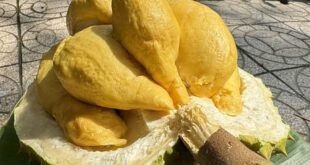For nearly 30 years, this Hanoi alley eatery has charged higher prices for che than anywhere else in Vietnam, twice as expensive as a bowl of hearty meaty pho.
Like other che (sweet soup) shops in Hanoi, the old 1976 shop, located in a narrow alley on Tran Hung Dao Street, features a compact two-story layout. Despite its humble appearance, the cups come with fancy prices.
Le Minh Dung, the 63-year-old owner, inherited the shop from her mother in 1996. When Dung took over, the price for a cup of che was approximately VND7,000, while a bowl of pho only cost VND3,500, and bun cha was priced around VND2,500. Over the course of 50 years, the price gradually increased because “both the quality and quantity warrant it,” according to the owner.
 |
|
Plastic cups of sweet up are ready for take-away orders at Dung’s shop. Photo by VnExpress/Tu Nguyen |
During the first five years, the shop struggled to attract customers. However, Dung’s mother refused to switch to selling savory dishes. By the 1980s, the shop began to gain popularity, and it became a snack spot for many families, some of which have now been eating here for three generations.
Each cup of che at this shop consists of approximately 18 ingredients, including green beans, coconut milk, fruit, and young green rice. Prices range from VND60,000 ($2.54) for the most affordable cup to VND90,000 for the most expensive option, which features durian and a lavish assortment of toppings. Served in generously sized cups, the most expensive cup of the is topped with a generous amount of coconut milk. The taste is a symphony of sweetness and balance, the perfect fusion of ingredients.
 |
|
A cup of mixed sweet soup features a generous amount of coconut milk, served with a cup of complementary jasmine tea and a bowl of ice. Photo by VnExpress/Tu Nguyen |
To enhance efficiency and serve customers more quickly, the cups of che are prepared in advance. Photo by VnExpress/Tu Nguyen
To create a balanced experience for customers, the shop also provides a complimentary cup of jasmine tea. Dung shared that when her mother ran the shop, she personally prepared the accompanying tea. However, due to increasing demand, Dung switched to using ready-made tea for convenience.
One distinct aspect of Dung’s shop is the inclusion of large tapioca pearls infused with flavors like chocolate, grapes, green beans, lotus, sesame, and coconut. As Dung’s mother originates from Phu Yen, a province on Vietnam’s south-central coast, the ingredients used in her che exhibit slight variations from those typically used in northern regions. Coconut green bean soup, for instance, is a signature sweet dish favored by people from the central and southern parts of Vietnam.
In addition to the tapioca pearls, the shop guarantees the use of fresh and top-notch seasonal fruits, including mangoes and durians. The cups of che here also feature stir-fried young green rice com, known for its aroma and tenderness. This ingredient has captured the hearts of many customers, including Xuan Lam, a 46-year-old resident of Hoang Hoa Tham Street.
 |
|
Stir-fried young green rice is cut into smaller pieces into cups of che at Dung’s eatery. Photo by VnExpress/Tu Nguyen |
Lam has been a loyal patron of the shop, visiting it every week since he was 14 years old, and he commented that the quality of the food has remained consistent over the span of almost five decades. Lam recalls that in the past, a cup of che would cost VND6,000, which was twice the price of a bowl of pho.
He said the che offered here is more suitable for those with a comfortable budget. “A cup of che now costs VND90,000, and not everyone can afford it,” he noted. But he also emphasized that he has been unable to find che of comparable quality elsewhere in Hanoi.
The shop owner admitted to receiving complaints about the price of her dessert. However, Dung firmly believes that the price is justified by the generous portions and selected ingredients. For example, the tapioca pearls with chocolate flavor contain imported chocolate from Germany, and the shop maintains a stock of around 500 bars. Although she experimented with locally available chocolates, she could not find any that matched her standards.
During its peak, Dung’s shop could sell approximately 1,600 cups of che per day. However, in recent years, the challenging economic situation has limited customer spending, resulting in about 700 cups sold per day.
Typically, the shop opens around 9 a.m. and operates until 10:30 p.m. During the day, it remains relatively quiet, but after 7 p.m., customers start flocking in. With around 15 employees, each staff often carries nearly 10 cups of tea at a time when the shop gets busy.
 |
|
A staff member holding six cups of che at the same time during peak time at Dung’s shop. Photo by VnExpress/Tu Nguyen |
Despite a decrease in the shop’s former bustling atmosphere, Dung remains determined not to lower the prices to attract more customers.
“Staying the same or increasing the price is an option, but lowering it is not,” she affirmed.
- Reduce Hair Loss with PURA D’OR Gold Label Shampoo
- Castor Oil Has Made a “Huge” Difference With Hair and Brow Growth
- Excessive hair loss in men: Signs of illness that cannot be subjective
- Dịch Vụ SEO Website ở Los Angeles, CA: đưa trang web doanh nghiệp bạn lên top Google
- Nails Salon Sierra Madre
 VnExpress News The News Gateway of Vietnam
VnExpress News The News Gateway of Vietnam





